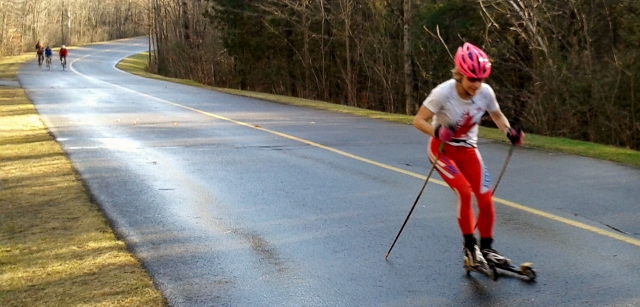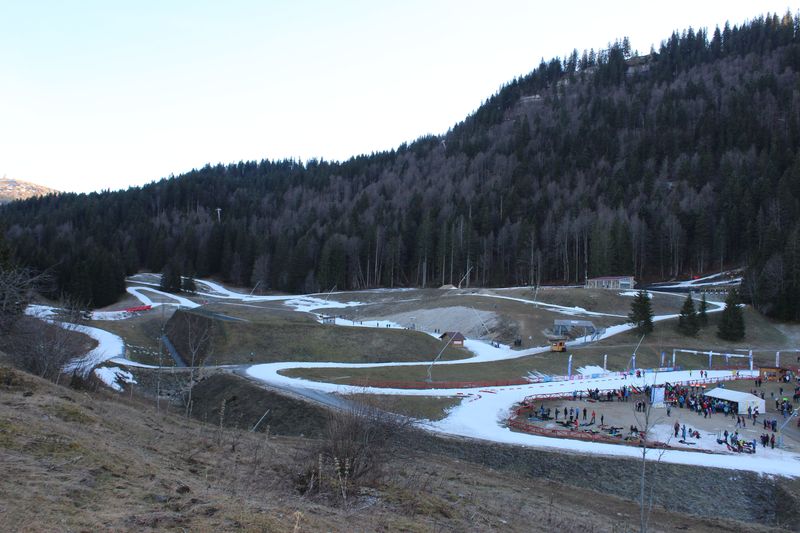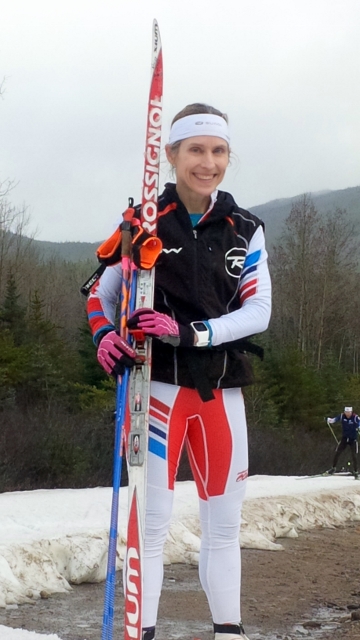Winter or not, cross country skiing thrives at some venues
By: Sheila Kealey (2015/12/28)
Although I live in Ottawa, the world’s coldest and snowiest capital, this year’s mild weather has meant a very slow start to the cross country ski season. Traditional holiday outdoor outings were replaced with other activities, and the beloved Boxing Day Burnoff was cancelled for the second year in a row due to lack of snow.
Here I am rollerskiing in unseasonably mild temperatures (17 deg C) on the Gatineau Parkway on Christmas eve, along with many cyclists.
Unfortunately, this is a snapshot of winters to come, and our precious ski season could be shortened to just a few months. Canada’s average winter temperatures are rising, and according to a recent analysis, climate change may shorten the ski season by a third over the next century.
Other countries with milder climates have taken measures to help extend the ski season or supplement natural snow to ensure that skiing and racing events are possible. While indoor facilities and snow-making are relatively new to cross-country skiing, these advancements occurred a while ago for ice sports and downhill skiing, where they are considered normal and a necessity.
Climate change has already affected winter sports in much of Europe, and many countries have taken steps to preserve the winter sports they love. In 2004 my XC Ottawa teammate Craig reported on how some countries extended the ski season with ski tunnels and cooled ski tracks. Things have evolved since then. Here’s a look at what some facilities have done to allow cross country skiers enjoy their sport despite the weather.
Europe
Skiing Inside – Tunnels and Arenas
Europe has at least eight ski tunnels, which means that cross-country skiing can be a year-long activity and taken indoors, similar to the popular ice skating rinks all over Canada. Sweden opened the Torsby ski tunnel in 2006, a facility geared to both recreational and elite athletes.
Finland is the world leader for indoor skiing, with six ski tunnels. My XC Ottawa teammates Karl and Megan visited Finland’s first ski tunnel, the impressive Vuokatti ski tunnel and ski loop in October 2014. One loop of the complete track is about 6 km of skiing. The video below gives you a pretty good idea of tunnel and artificial loop skiing.
Germany has the popular Oberhof ski tunnel facility. They also host the largest biathlon event in the world – Biathlon auf Schalke (World Team Challenge) in the Veltins arena, an indoor stadium that also serves as a football stadium, ice hockey arena, a handball hall or a concert venue. Here’s a video of this year’s competition.
Snow-Making
Snow-making is a necessity at most European Nordic ski areas. In fact, most of the European FIS Word Cup races are possible because of artificial snow. Often racers are skiing on a white ribbon of man-made snow starkly contrasting a green background. Some facilities store man-made snow from the previous winter, and lay it out as a base for more man-made snow. Skiers can typically start skiing outdoors as early as October at these centers.
In Norway, skiers could ski outdoors at the end of September this year at the Sjusjøen Skisenter facility.
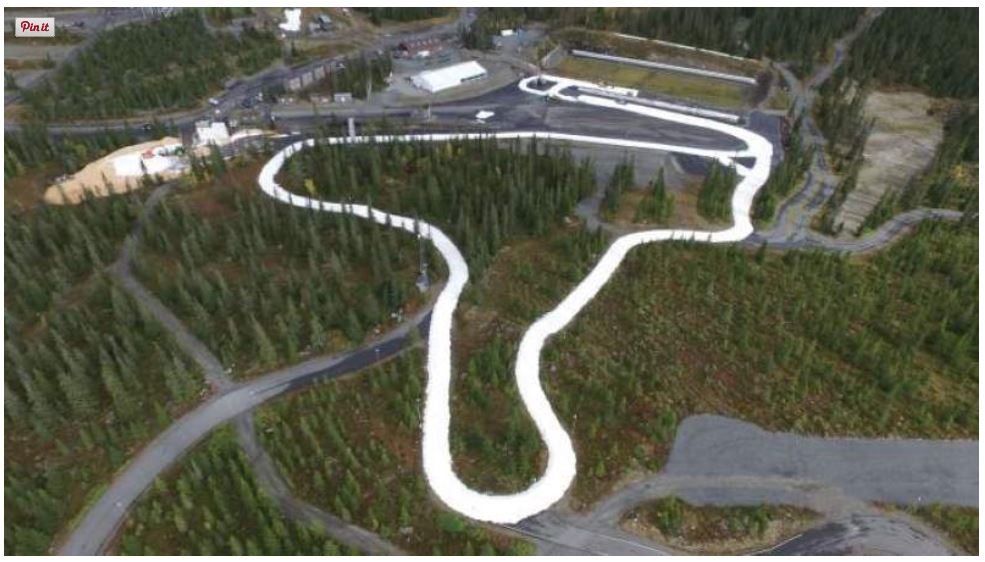 In Italy, the first of the Ski Classics series race in December, the La Sgambeda Loppet was possible, thanks to artificial snow.
In Italy, the first of the Ski Classics series race in December, the La Sgambeda Loppet was possible, thanks to artificial snow.
In France, the French Championships get underway this week at the Stade des Tuffes facility, on a bed of artificial snow.
United States and Canada
Although snow-making was once exclusively the realm of downhill ski venues in the US and Canada, a growing number of US Nordic Centers have realized the importance of investing in artificial snow, as I noted last week. The US has over 30 Nordic Centers that make snow, and many believe that snow-making is an essential component of cross country ski facilities. The New York Times highlighted the trend of New England ski centers in this article Creating Winter for Cross Country Skiers.
The State of Vermont has at least seven facilities that make snow. Craftsbury Outdoor Center began snowmaking in 2011 and the track seems to improve every year. They hosted over 500 racers at the successful NENSA season opener last weekend (the 5 km event is pictured below), thanks to snow-making.
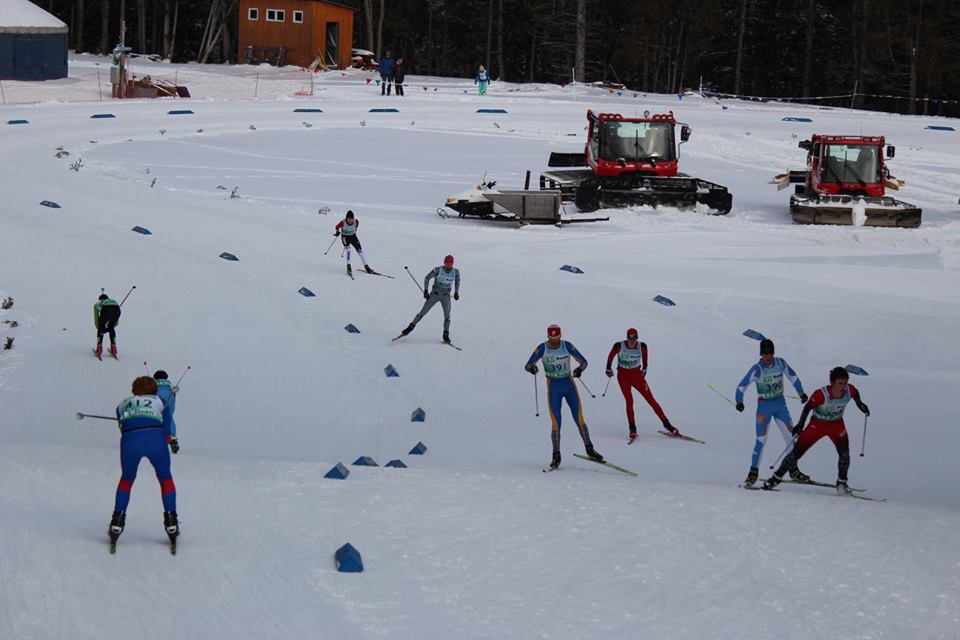 5km course on Craftsbury Man-Made Loop (NENSA photo)
5km course on Craftsbury Man-Made Loop (NENSA photo)
Last year I raced at the NENSA opener in Rikert Nordic Center in Middleburry, Vermont, also made possible by artificial snow. Boston-area skiers also benefit from artificial snow.
In Canada, the cooler climate has allowed cross country skiers to rely on Mother Nature, but the last decade has seen increasingly short cross country ski seasons. Only a few places have invested in snow-making or snow preservation. In the East, Foret Montmorency is a popular nordic facility with snow-making and snow preservation. La Foret staff stock at least 6,000 m of the previous year’s snow under a thick coat of sawdust and top it off with man-made snow, to guarantee a 2km ski loop. The loop includes steep uphills, downhills, and technical turns. Here’s a picture from this November 2015 at Montmorency: after a week of rain, the skiing was still good and snow depth impressive.
In Western Canada, skiers in Canmore benefit greatly from Frozen Thunder at the Canmore Nordic Center, which typically opens in late October. Frozen Thunder is possible because man-made snow from the previous year that is stored for this purpose. And lucky skiers in Edmonton may soon see a longer ski season thanks to a partnership between the City of Edmonton and Edmonton Nordic Ski Club (ENSC).
It is fascinating to see how Europe has remained enthusiastic about cross country skiing despite the warming of their winter season and challenges in producing ski venues. As our winters get warmer, perhaps we can learn from their endeavours to keep the sport alive.

